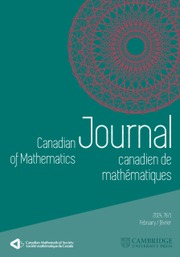Article contents
Spectral Inclusion and C.N.E.
Published online by Cambridge University Press: 20 November 2018
Extract
1. An n-tuple S = (S 1, …, Sn ) of commuting bounded linear operators on a Hilbert space H is said to have commuting normal extension if and only if there exists an n-tuple N = (N 1, …, Nn ) of commuting normal operators on some larger Hilbert space K ⊃ H with the restrictions Ni|H = Si, i = 1, …, n. If we take

the minimal reducing subspace of N containing H, then N is unique up to unitary equivalence and is called the c.n.e. of S. (Here J denotes the multi-index (j 1, …, jn ) of nonnegative integers and N *J = N 1 *jl … Nn *jn and we emphasize that c.n.e. denotes minimal commuting normal extension.) If n = 1, then S 1 = S is called subnormal and N 1 = N its minimal normal extension (m.n.e.).
Information
- Type
- Research Article
- Information
- Copyright
- Copyright © Canadian Mathematical Society 1982
References
References>
- 2
- Cited by

